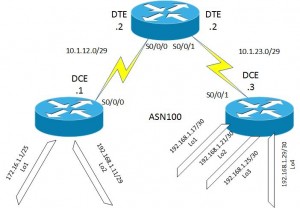So lets dive into Day 2,
One of the things I will also aim to do is re-create the topologies in Packet Tracer and upload the files for your use at some point in the future, here’s what we covered today;
- EIGRP Cont…
- EIGRP Authentication
- EIGRP Summerization
- EIGRP route propagation
- EIGRP Stub Networks
- EIGRP Timers
- OSPF Intro
EIGRP Cont…
Lets refresh ourselves on the topology we are using for this routing protocol
To change max paths for a route to a network
- router eigrp [ASN]
- maximum-paths [VALUE]
Unequal Load Balancing
- router eigrp [ASN]
- variance [VALUE]
- Use “sh ip eigrp topology” and “sh ip route” for verifying configuration
EIGRP Authentication
- From global configuration mode;
- key chain [NAME]
- Key [VALUE]
- Key-string [VALUE]
- accept-lifetime (Start[HH:MM:SS] [DD Month YY]) (End[HH:MM:SS] [DD Month YY])
- send-lifetime (Start[HH:MM:SS] [DD Month YY]) (End[HH:MM:SS] [DD Month YY])
- interface INT
- ip authentication key-chain eigrp [ASN] [key chain name]
- ip authentication mode eigrp [ASN] md5
To troubleshoot use “debug ip eigrp packets” and “show key chain”
Note: See below for screenshots
Example configuration
key chain CCNP key 1 key-string cisco accept-lifetime 10:00:00 02 sept 2014 10:15:00 02 sept 2014 send-lifetime 10:00:00 02 sept 2014 10:15:00 02 sept 2014 key 2 key-string cisco2 accept-lifetime 10:14:00 02 sept 2014 10:15:00 22 sept 2014 send-lifetime 10:14:00 02 sept 2014 10:15:00 22 sept 2014 key 3 key-string cisco3 accept-lifetime 10:00:00 02 sept 2014 10:15:00 02 sept 2014 send-lifetime 10:00:00 02 sept 2014 10:15:00 02 sept 2014 key 4 key-string cisco4 accept-lifetime 10:16:00 02 sept 2014 10:20:00 02 sept 2014 send-lifetime 10:16:00 02 sept 2014 10:20:00 02 sept 2014 key 5 key-string cisco5 accept-lifetime 10:19:00 02 sept 2014 10:25:00 02 sept 2014 send-lifetime 10:19:00 02 sept 2014 10:25:00 02 sept 2014 key 6 key-string cisco6 accept-lifetime 10:24:00 02 sept 2014 10:35:00 02 sept 2014 send-lifetime 10:24:00 02 sept 2014 10:35:00 02 sept 2014
interface ser0/0/0 ip authentication key-chain eigrp 100 CCNP ip authentication mode eigrp 100 md5 interface ser0/0/1 ip authentication key-chain eigrp 100 CCNP ip authentication mode eigrp 100 md5 exit exit debug eigrp packets
EIGRP Summerization
Here is the above topology cut down slight, basically turn R4 off, and add some more loop back adapters to R1 and R3.
Note: Fogive the shoddy displaying of the loopback adapters
To manually summarise addresses, first turn off auto summary
- router eigrp [ASN]
- no auto-summary
to enter a manual summerisation this is done at the interface level
- interface INT
- ip summary-address eigrp [ASN] [SUBNET] [NETMASK]
See the below screenshots showing the routing table before hand (take note of the routes in yellow)
then after entering the configuration, the show ip route command output again (take note of the yellow again.

EIGRP route propagation
Ok so take a look at the topology below, at the time of writing this, I wont be telling you how to set this up from scratch, the topics are covered in the CCNA, and if you can’t remember, it’s a good design to dig into, create on packet tracer and troubleshoot!
You’ll notice that by entering on Router 2
ip default network 192.168.5.0
This gives R1 a gateway of last resort.
Before config
After config – shows the config entered on R2 and then the output of R1 again
EIGRP Stub Networks
Send only connected routers
router eigrp [ASN] eigrp stub connected
Send only summary of routes known
router eigrp [ASN] eigrp stub summary
Send connected and summary routes (Default setting)
router eigrp [ASN] eigrp stub
Send no routes
router eigrp [ASN] eigrp stub recieve-only
EIGRP Timers
Configured on the interface, in the topology examples this would be done on the serial interfaces
interface [INT] ip hello-interval eigrp [ASN] [SECONDS] ip hello-time eigrp [ASN] [SECONDS]
Usually what every you set at “hello-interval” you would times this by 3 for “hello-time”
OSPF
Ok so lets look at the topology first, the switch needs to be flat with no config on, or at least all routers need to be in the same VLAN if you already configuring switches for yourself.
Im going to put all the notes from OSPF from Day 2 into Day 3 to keep it a little more consistent.
Ciao for now














